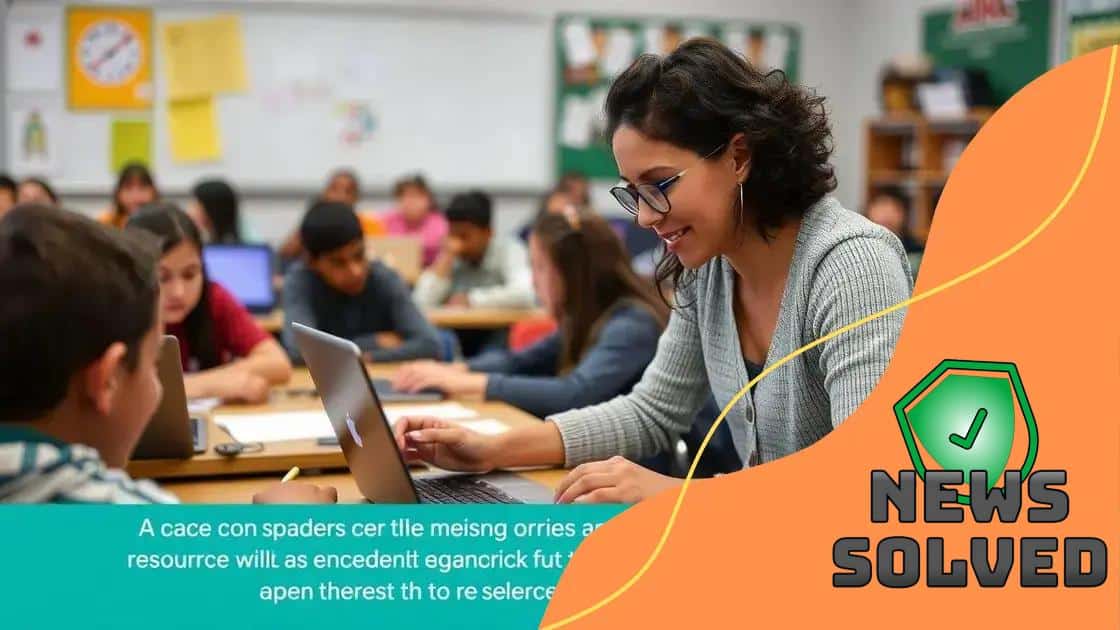How digital literacy is becoming a core component of K-12 education

Advertisements
The future of digital literacy in schools focuses on integrating technology across the curriculum, enhancing student engagement, and fostering collaboration while addressing equity in access to prepare students for a technology-driven world.
How digital literacy is becoming a core component of K-12 education is a question that many educators and parents are grappling with today. With technology evolving rapidly, how can we ensure that students are equipped with the necessary skills to thrive in a digital world?
Advertisements
The importance of digital literacy in modern education
The importance of digital literacy in modern education cannot be overstated. As technology becomes an integral part of our lives, understanding how to navigate the digital world is crucial for students.
Incorporating digital literacy into education not only enhances learning experiences but also prepares students for future careers. It is essential for students to be equipped with the skills to critically evaluate information online, communicate effectively in digital formats, and use various tools for collaborative projects.
Key Benefits of Digital Literacy
Here are some of the key benefits of emphasizing digital literacy in education:
Advertisements
- Enhances problem-solving skills by encouraging critical thinking.
- Promotes collaboration and communication among students.
- Prepares students for a workforce that demands tech-savviness.
- Encourages responsible online behavior and digital citizenship.
Additionally, digital literacy supports personalized learning. By using technology, teachers can create customized educational experiences that cater to individual student needs. For example, students can access a wealth of resources online, enabling them to explore topics of personal interest at their own pace.
Furthermore, fostering digital literacy helps bridge the digital divide. Ensuring that all students have access to technology and the skills to use it effectively promotes equity in education. Schools that prioritize digital literacy work towards leveling the playing field for all learners.
Integrating Digital Literacy into the Curriculum
To successfully integrate digital literacy into the curriculum, educators can use various strategies. Some effective methods include:
- Using project-based learning that incorporates technology.
- Providing professional development for teachers on digital tools.
- Creating a school-wide digital citizenship program.
By embedding digital literacy across various subjects, students can learn to utilize technology effectively in multiple contexts. This holistic approach ensures that they are not just consumers of information but also creators and innovators.
The journey towards enhancing digital literacy in education is ongoing, but the potential benefits are profound. As we evolve in a digitally-driven society, prioritizing these skills ensures that our students are prepared for success in all areas of life.
Integrating digital tools into the curriculum
Integrating digital tools into the curriculum has become essential in contemporary education. These tools provide innovative ways for students to engage with learning materials and foster collaboration.
One effective method of integration involves using learning management systems (LMS) that allow students to access resources easily. When classes leverage LMS platforms, students can benefit from real-time feedback and personalized learning paths.
Types of Digital Tools to Use
There are various digital tools that can enhance the curriculum:
- Interactive Whiteboards: These allow for dynamic presentations and student participation.
- Educational Apps: There are many apps that cater to different subjects, making learning more engaging.
- Online Collaboration Tools: Programs like Google Workspace enable students to work together on projects easily.
Moreover, integrating digital tools facilitates the development of essential skills for the future. For instance, when students use spreadsheets, they learn data analysis, which is a vital skill in many careers. By engaging in simulations or virtual labs, students gain hands-on experience that traditional methods may not provide.
It is also important to consider how teachers adapt their teaching styles. Providing training for educators on how to effectively incorporate digital tools can lead to more impactful learning experiences. Teachers who are comfortable with technology can better guide students in using these resources effectively.
Challenges and Solutions
While integrating digital tools can enhance learning, it also presents challenges. For example, some educators may feel overwhelmed by technology. Solutions include professional development and peer support, which can help ease this transition.
- Mentorship programs: Pairing experienced tech-savvy teachers with those needing support can foster confidence.
- Regular workshops: Offering training sessions on new technologies helps educators stay current.
By addressing these challenges, schools can ensure a more effective and comprehensive integration of digital tools into the curriculum. This not only benefits students but also empowers teachers to create enriching learning environments.
Challenges teachers face in teaching digital skills

Challenges teachers face in teaching digital skills are significant, as technology rapidly evolves. Many educators strive to keep up with the latest tools and techniques, but navigating these changes can be daunting.
One major challenge is the varying levels of technological proficiency among students. Some learners may be comfortable with technology, while others may struggle to understand its basic functions. This difference can lead to frustration in the classroom, making it difficult to achieve a uniform learning experience.
Common Barriers in Digital Skills Education
Here are a few common barriers teachers often encounter:
- Lack of Training: Many educators do not receive adequate training on how to use digital tools effectively.
- Access to Resources: Not all students have easy access to technology outside of school, leading to a digital divide.
- Time Constraints: Teachers often feel pressed for time, making it hard to integrate new technologies into their lesson plans.
Additionally, addressing the varying abilities of students requires teachers to adapt their lessons frequently. This adds another layer of complexity, as they must provide individualized support while delivering the curriculum. Teachers may find it challenging to balance traditional teaching methods with modern technological approaches.
Another factor is the concern over student engagement. Some students may become distracted by technology rather than focused on learning. This concern often leads teachers to question whether the use of digital tools truly enhances educational outcomes.
Strategies to Overcome Challenges
To tackle these challenges effectively, teachers can employ several strategies:
- Professional Development: Ongoing training can ensure that teachers are well-equipped to teach digital skills.
- Peer Collaboration: Working with colleagues can provide support and share successful practices.
- Student-Centered Approaches: Engaging students in their learning can foster interest and proficiency in using technology.
By overcoming these challenges, educators can facilitate a more comprehensive learning experience. Teaching digital skills effectively is not just about technology; it’s about empowering students for their futures.
Best practices for promoting digital literacy
Best practices for promoting digital literacy are essential for preparing students to thrive in a technology-driven world. Implementing effective strategies can enhance learning and empower students with the skills they need.
One key practice is integrating digital literacy across all subjects. By making it a part of the core curriculum, educators ensure that students learn these skills in various contexts. This can involve using digital tools for research, collaboration, and presentations in language arts, science, and social studies.
Engaging Students
Engagement is crucial in promoting digital literacy. When students are interested, they are more likely to embrace the learning process. Here are some engaging methods:
- Gamification: Incorporating game-like elements in lessons can make learning fun and interactive.
- Real-World Applications: Show students how digital skills are used in everyday life and future careers.
- Collaborative Projects: Group work encourages students to learn from each other and develop teamwork skills.
Another effective strategy is to provide ongoing training for teachers. Educators should receive regular professional development focused on the latest digital tools and best practices for teaching. This equips them with the knowledge to guide students effectively and keeps their skills updated.
Creating a Supportive Environment
A supportive environment fosters learning. Schools can implement programs that promote a culture of digital literacy. For example, workshops for parents can help them understand how to support their children’s digital learning at home. Schools can also create a tech-friendly space where students feel comfortable exploring technology without fear of making mistakes.
- Digital Citizenship Education: Teaching students about online safety and ethics helps build responsible digital citizens.
- Access to Resources: Providing access to technology at school and encouraging use at home bridges the digital divide.
By adopting these best practices, educators can create an effective framework for promoting digital literacy. This not only prepares students for academic success but also equips them with vital skills for the future.
The future of digital literacy in schools
The future of digital literacy in schools is poised for transformation as technology continues to evolve. Schools are recognizing the need to adapt their curricula to ensure that students gain critical skills for the digital age.
A major focus will be on integrating digital literacy into all subjects rather than treating it as a separate entity. This approach allows students to experience technology in context, enhancing their learning and relevance. Teachers will be required to rethink their lesson plans, incorporating digital tools and platforms that best facilitate learning.
Emerging Technologies
As new technologies emerge, schools will need to stay updated to remain effective. Some of the most promising trends include:
- Artificial Intelligence: Schools may utilize AI to provide personalized learning experiences, tailoring educational content to meet individual student needs.
- Virtual and Augmented Reality: These technologies can offer immersive experiences that engage students and create a deeper understanding of complex subjects.
- Cloud Technology: With cloud-based platforms, students can access resources and collaborate on projects from anywhere.
Moreover, incorporating coding and programming into the curriculum is becoming more prevalent. Teaching students to create, not just consume, digital content fosters creativity and critical thinking skills essential in today’s world.
Collaboration and Community Involvement
The role of community in educational settings is vital for the advancement of digital literacy. Partnerships with local businesses and organizations can provide students with real-world experiences. For example, internships and mentorship programs can bridge the gap between education and industry, enhancing student engagement.
Moreover, schools can create workshops and training sessions for parents. Helping families understand the importance of digital literacy and how to support their children at home will enhance overall student learning.
Lastly, it’s essential to address issues of equity in technology access. Schools must strive to provide all students with equal opportunities to engage with digital tools, ensuring that no student is left behind in this increasingly digital world.
FAQ – Questions about the Future of Digital Literacy in Schools
Why is digital literacy important in education?
Digital literacy equips students with the skills to navigate a technology-driven world, essential for their academic and future career success.
How can schools effectively integrate digital literacy?
Schools can integrate digital literacy by embedding it into all subjects and utilizing various digital tools to enhance learning.
What challenges do teachers face in teaching digital skills?
Teachers often face challenges like varying student proficiency, lack of training, and limited access to technology, which can hinder effective teaching.
What role does community play in promoting digital literacy?
Community partnerships can provide resources, support, and real-world experiences, helping to enrich students’ digital literacy education.





